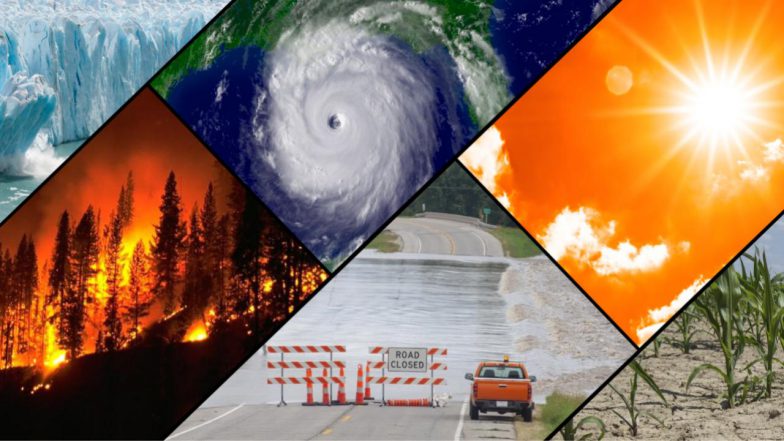Summary
Climate change refers to long-term shifts in temperature and weather patterns, primarily driven by human activities like burning fossil fuels. These shifts result in rising global temperatures, altered precipitation patterns, and more frequent and intense extreme weather events.
In essence, climate change is a global phenomenon with far-reaching consequences for the planet and its inhabitants.
Source: Other
British International Investment – 12/06/2025 (04:18)
A brief understanding of what causes Climate Change, what it could mean, and why it’s urgent that we do something about it.
OnAir Post: Climate Change
News
For the first time, social media overtakes TV as Americans’ top news source
There’s always been a lot of hand wringing over how the “mainstream media” covers particular issues, especially political ones, but we’re at a point where the term “mainstream media” is pretty much an anachronism. Independent media wields significant influence now, and we have the collective ability to drive attention and interest toward issues regardless of how they’re covered by the legacy media. That’s not to say that traditional media doesn’t continue to play an important role in our information ecosystem, but it’s no longer the gatekeeper it once was. [Nieman Lab]
$250K from LinkedIn in one year
Platforms like Threads and Bluesky are often cited as the main Twitter competitors, but LinkedIn was probably the greatest beneficiary of the post-Elon Twitter exodus, especially since it absorbed a lot of the business influencers who used to publish long viral tweet threads. I think one of LinkedIn’s biggest assets is that it doesn’t have restrictive character limits, and instead simply hides longer posts behind a “read more” button. This allowed people to start using it as something closer to a real blogging platform — a more scalable Medium, at least when it comes to business content. [Creator Spotlight]
About
Source: Gemini AI Overview
What is Climate Change?
- Long-term shifts
Climate change signifies a significant and lasting change in average weather conditions over several decades or longer. This includes changes in temperature, rainfall, and wind patterns.
- Human-caused
While natural processes can also contribute to climate change, the current warming trend is largely attributed to human activities that release greenhouse gases into the atmosphere.
- Greenhouse gases
Gases like carbon dioxide and methane trap heat in the atmosphere, causing a warming effect.
- Observed Effects
Climate change has numerous observable effects, including rising temperatures, sea level rise, melting glaciers and ice sheets, and changes in precipitation patterns.
Key Aspects of Climate Change
- Global Warming
A major aspect of climate change is the increase in Earth’s average temperature, with 2024 being the warmest year on record.
- Extreme Weather
Climate change is associated with more frequent and intense heatwaves, droughts, floods, and storms.
- Impacts on Ecosystems
Changes in climate can disrupt ecosystems, affecting plant and animal life, migration patterns, and growing seasons.
- Impacts on Humans
Climate change can lead to food and water shortages, displacement due to rising sea levels, and increased risks to human health.
Problems/Challenges
Climate change presents a complex web of challenges, with some of the most pressing being extreme weather events, threats to food and water security, and impacts on human health. These issues are interconnected, and their effects are felt across the globe, disproportionately impacting vulnerable populations.
These are just some of the major challenges posed by climate change. The complexity and interconnectedness of these issues mean that addressing them requires a multifaceted approach involving international cooperation, technological innovation, and significant changes in human behavior.
Initial Source for content: Gemini AI Overview 7/8/25
[Enter your questions, feedback & content (e.g. blog posts, Google Slide or Word docs, YouTube videos) on the key issues and challenges related to this post in the “Comment” section below. Post curators will review your comments & content and decide where and how to include it in this section.]
1. Extreme Weather Events
- Increased frequency and intensity
Heatwaves, droughts, floods, and wildfires are becoming more common and severe, causing widespread damage to infrastructure, agriculture, and ecosystems.
- Sea level rise
Coastal communities face increased risk of flooding and displacement due to rising sea levels.
- Disruptions to ecosystems
Shifting weather patterns can disrupt natural habitats, impacting biodiversity and leading to species extinction.
2. Food and Water Security
- Agricultural impacts
Changing rainfall patterns and increased temperatures can reduce crop yields, leading to food shortages and price increases.
- Water scarcity
Droughts and reduced snowpack can limit access to fresh water for drinking and agriculture.
- Increased competition for resources
Climate change can exacerbate existing resource conflicts, particularly in regions already facing water scarcity.
3. Human Health Impacts
- Extreme heat
Heatwaves can lead to heatstroke, dehydration, and exacerbate existing cardiovascular and respiratory problems.
- Air and water quality
Wildfires and droughts can worsen air quality, while flooding can contaminate water sources with pollutants and pathogens.
- Spread of disease
Changes in temperature and rainfall patterns can affect the spread of disease vectors like mosquitoes, increasing the risk of vector-borne illnesses.
4. Social and Economic Impacts
- Displacement and migration
Extreme weather events and resource scarcity can force people to relocate, leading to increased migration and displacement.
- Economic losses
Damage to infrastructure, agriculture, and tourism can result in significant economic losses.
- Social inequality
The impacts of climate change are not evenly distributed, with vulnerable populations often bearing the brunt of the consequences.
5. Ecosystem Collapse
- Biodiversity loss
Many species are struggling to adapt to rapid climate change, leading to habitat loss and potential extinction.
- Ocean acidification and warming
Rising ocean temperatures and increased acidity can harm marine ecosystems, including coral reefs and fisheries.
- DeforestationForests are important carbon sinks, and deforestation contributes to climate change while also reducing biodiversity.
Research/Innovations
Several key research areas and innovations are crucial for addressing climate change challenges. These include advancements in renewable energy, energy storage, carbon capture and storage (CCS), and sustainable agriculture. Additionally, the development of new technologies like direct air capture and utilization of CO2, along with the integration of AI and other technologies like drones and satellite imagery for environmental monitoring and management, are essential.
These are just a few examples of the many innovative approaches being developed to address the complex challenges of climate change. Continued research, technological innovation, and policy changes are crucial to achieving a sustainable future.
Initial Source for content: Gemini AI Overview 7/8/25
[Enter your questions, feedback & content (e.g. blog posts, Google Slide or Word docs, YouTube videos) on innovative research related to this post in the “Comment” section below. Post curators will review your comments & content and decide where and how to include it in this section.]
1. Renewable Energy & Energy Storage
- Advancements in solar, wind, and geothermal energy
Continued research and development are needed to improve the efficiency and affordability of these technologies.
- Innovative energy storage solutions
This includes advanced batteries, pumped hydro storage, and other technologies to address the intermittency of renewable sources.
- Green Hydrogen
Producing hydrogen from renewable energy sources could revolutionize various sectors, including transportation and heavy industry.
2. Carbon Capture, Utilization, and Storage (CCUS)
- Direct Air Capture (DAC)
Removing CO2 directly from the atmosphere is crucial for addressing historical emissions and offsetting emissions from hard-to-abate sectors.
- Improved CCS technologies
This involves capturing CO2 from industrial sources and storing it underground or utilizing it in various products.
3. Sustainable Agriculture
- Precision Agriculture
Using sensors, drones, and AI to optimize resource use (water, fertilizer, etc.) in agriculture.
- Carbon Farming
Practices that enhance carbon sequestration in soils and promote sustainable land management.
- Resilient Crops
Developing crops that can withstand the impacts of climate change, such as drought and extreme temperatures.
4. AI and Emerging Technologies
- AI-powered climate models
Analyzing vast datasets to improve predictions of climate change impacts and inform mitigation and adaptation strategies.
- Drones for environmental monitoring
Assessing deforestation, tracking glacier melt, and monitoring other climate-related changes.
- Satellite imagery for deforestation monitoring and other applications
Providing valuable data for understanding and addressing climate change impacts.
- AI-powered waste management and circular economy solutions
Optimizing recycling processes and promoting resource efficiency.
5. Climate-Resilient Infrastructure and Urban Planning
- Developing infrastructure that can withstand extreme weather events
Building resilient transportation systems, water management systems, and buildings.
- Sustainable urban planning
Designing cities that are less vulnerable to climate change impacts and promote green spaces and efficient transportation.
6. Addressing social and economic challenges
- Climate Justice
Recognizing that climate change disproportionately impacts vulnerable populations and ensuring equitable solutions. - Behavioral changes
Encouraging individuals and communities to adopt sustainable practices. - International cooperation
Addressing climate change requires global collaboration and coordinated action.
Solutions/Projects
Addressing climate change requires a multi-faceted approach encompassing both mitigation and adaptation strategies, involving diverse solutions and projects across various sectors.
Collaboration and supportive government policies are essential to drive the adoption and implementation of these solutions.
Initial Source for content: Gemini AI Overview 7/8/25
[Enter your questions, feedback & content (e.g. blog posts, Google Slide or Word docs, YouTube videos) on current and future projects implementing solutions to this post challenges in the “Comment” section below. Post curators will review your comments & content and decide where and how to include it in this section.]
1. Mitigation Solutions & Projects
- Transitioning to Renewable Energy
This involves shifting away from fossil fuels and investing in sources like wind, solar, geothermal, and hydroelectric power. Projects like Tesla’s Gigafactories and offshore wind farms are examples of this transition. AI and Machine Learning can optimize energy management and renewable energy use. - Improving Energy Efficiency
Implementing energy-efficient solutions in buildings, transportation, and industries is crucial. This includes using heat pumps, LED lighting, and improving insulation. Smart grids and demand-side management techniques help optimize energy distribution. - Sustainable Transportation
Promoting electric vehicles and expanding charging infrastructure is important. Investing in and enhancing public transportation systems also helps reduce individual car use. AI and smarter urban planning can optimize transportation efficiency. - Sustainable Forestry and Agriculture
Protecting and restoring forests acts as carbon sinks. Adopting organic and regenerative agriculture practices improves soil health and reduces emissions. Climate-smart agriculture uses technology like precision farming and drought-resistant crops. Agrivoltaics combines solar energy generation with agriculture. - Carbon Capture and Storage (CCS)
This involves developing technologies to capture CO2 emissions from industrial sources and the atmosphere, including Direct Air Capture (DAC) and Bioenergy with Carbon Capture and Storage (BECCS). - Circular Economy and Waste Reduction
Shifting to a regenerative and circular economy helps reduce waste. AI can aid in efficient recycling and waste management. - Other Promising Technologies
These include Blockchain for transparent carbon markets, Quantum computing for material development, Robotics for various applications, and AI for optimization and monitoring.
2. Adaptation Solutions & Projects
- Building Resilient Infrastructure
This involves constructing flood defenses, improving drainage, and developing infrastructure resistant to extreme weather. Initiatives like the Coalition for Disaster-Resilient Infrastructure promote resilience. - Climate-Smart Agriculture
This includes planting drought-resistant crops and improving irrigation. Programs like the MAIS Program in Brazil support family farms in adapting. - Water Management
Implementing water-saving technologies, rainwater harvesting, and efficient irrigation systems are key. Green Machine’s waterless car wash is an example of a solution for water scarcity. - Ecosystem-Based Adaptation
Restoring ecosystems like mangroves provides defense against sea-level rise and storm surges. Using coconut fibers to protect shorelines is also being explored. - Early Warning Systems
Developing systems powered by technologies like Earth observation and drones can help anticipate climate disasters. - Social and Community Adaptation
Strengthening social protection, providing climate insurance, and promoting livelihood diversification are important. Educating for climate action empowers youth and encourages sustainable choices.


